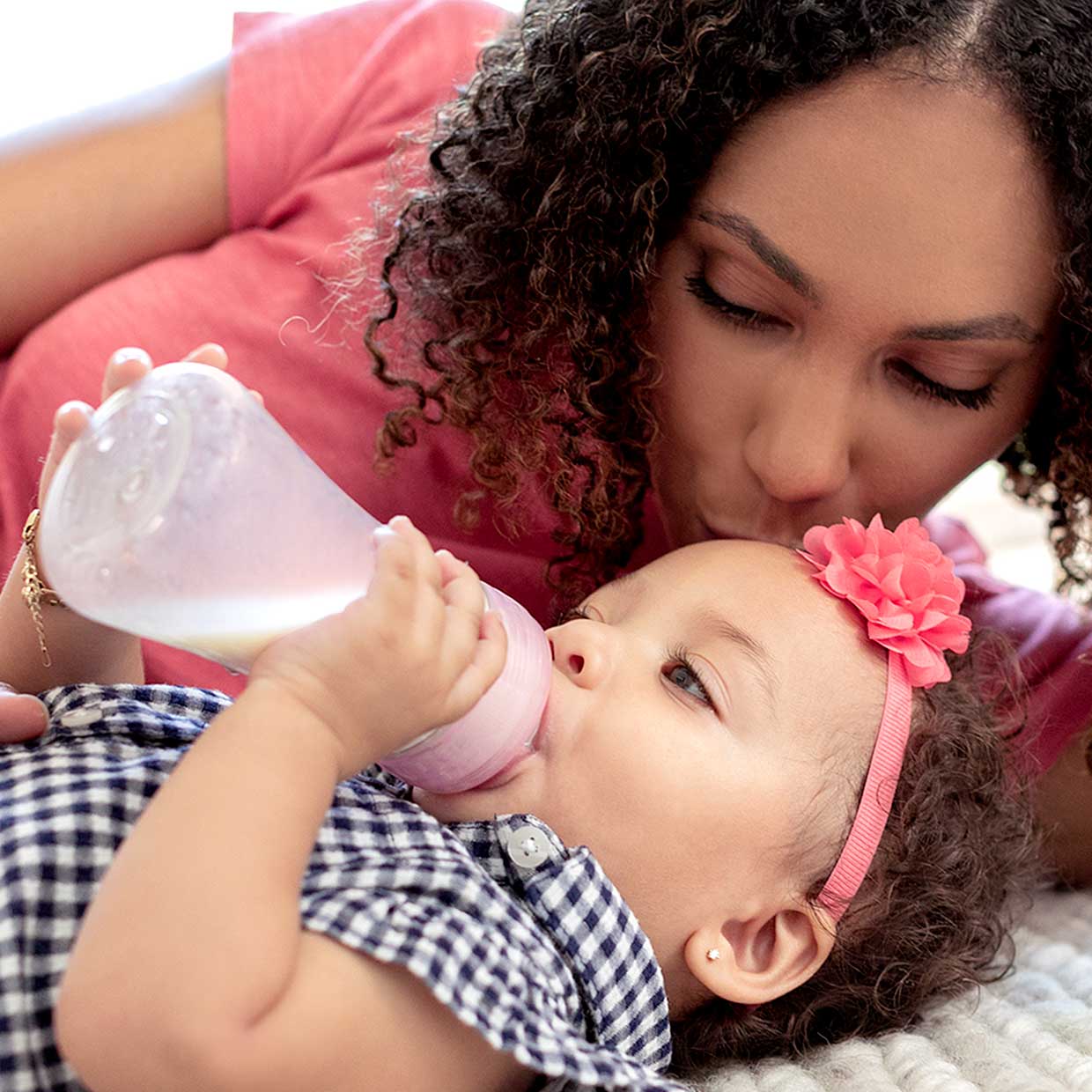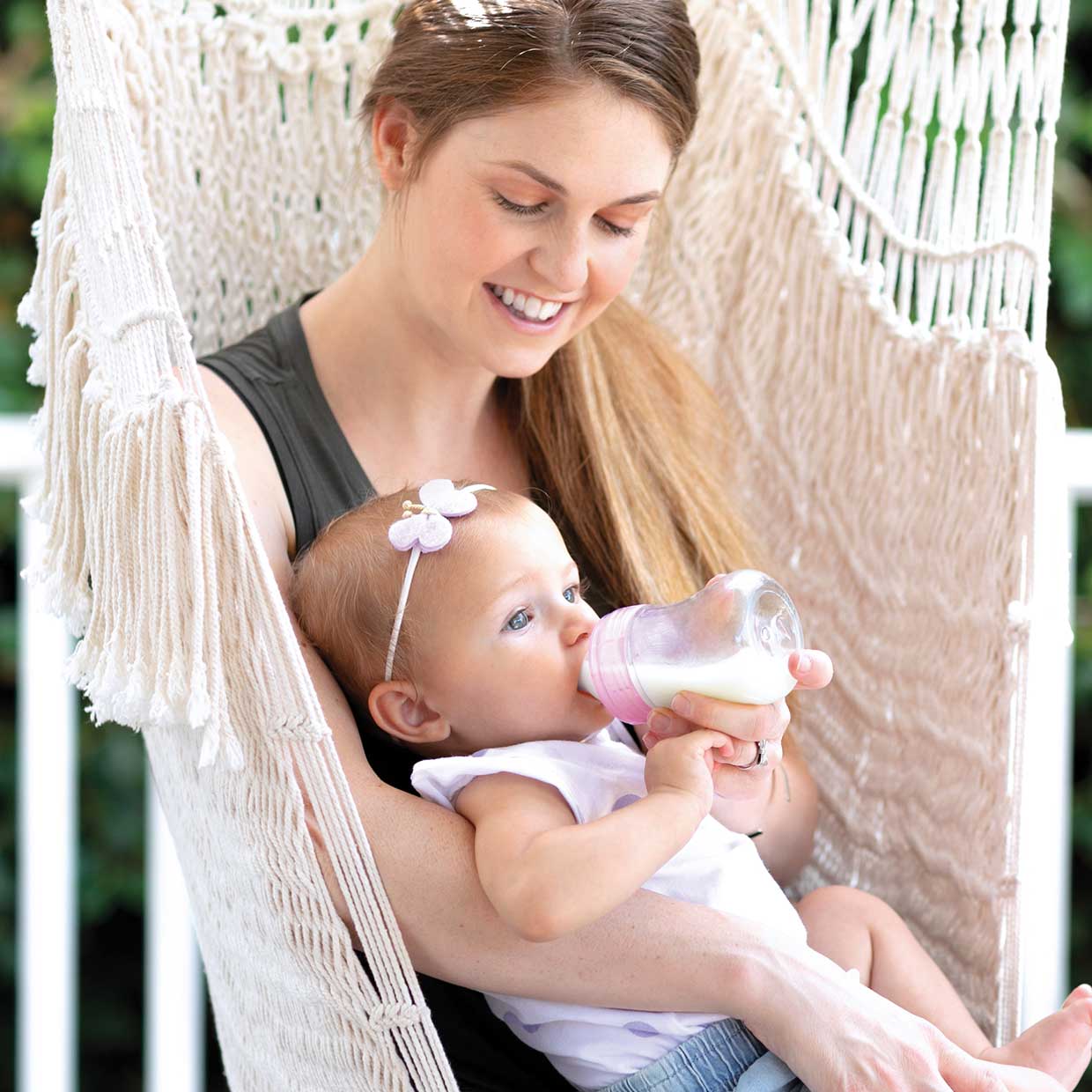
As you cradle your baby in your arms and feed them their bottle for what might seem like the gazillionth time, you may be thinking of the monthly baby milestones that lie ahead; like the day your little one will learn how to tie their own shoes, clean up after themselves — or even sip out of their bottle on their own. While holding a bottle may pale in comparison to other milestones, it’s actually a huge achievement! Plus, it gives you one more free hand (which every parent could use!)
As each baby develops their gripping and self-feeding skills at their own pace, it’s natural to wonder, "When will my baby be able to hold the bottle independently?". Our guide will help you to understand the timing of this milestone, offer practical tips on how to encourage your baby to hold their own bottle, and much more.
The timing of when babies begin to hold their own bottles varies widely. While some little ones confidently grasp their bottles as early as 6 months, others may take until around 14 months to develop that skill. This milestone typically occurs between the ages of 6 to 10 months.
There are instances where babies who were initially breastfed are introduced to bottles later on, such as when their mothers need to return to work, which can contribute to the later timeline. Other babies may show no interest in holding their own bottle and may find comfort and security in having you hold it for them. After all, who doesn’t like to be waited on hand and foot? So long as your little peanut is achieving other developmental milestones, there’s no cause for alarm. However, you can always contact your pediatrician with any concerns.
There are a few different signs that indicate your baby may be ready to hold their own bottle. Keep an eye out for these developmental cues:
- Your Baby Shows an Interest and Reaches for the Bottle: You may notice that during feedings, your little one starts reaching out for the bottle, showing an interest in holding it. This curiosity can be an early indicator that they are ready to take on this task independently.
- Sitting Up On Their Own: A crucial milestone in bottle-holding readiness is when your baby can sit up unassisted. This ability ensures that they have the necessary strength and coordination to hold the bottle at a proper angle and not drink while lying flat on their back, reducing the risk of choking.
- Your Baby Has Mastered Gripping and Hand-Mouth Coordination: As your baby grows and develops, they begin to acquire fine motor skills, including the ability to grip objects and bring them to their mouth (and we’re not just talking about their feet). When your little one demonstrates proficiency in grasping and exploring toys or other items, it's a strong indicator that their hand-mouth coordination is improving, setting the stage for holding their bottle.
- Placing Hands on the Bottle: Another encouraging sign is when your baby starts placing one or both hands on the bottle while you hold it for them. This action demonstrates their growing desire for greater independence and a readiness to participate actively in the feeding process!
Bottle propping might be touted as a parenting life hack, but this practice isn’t safe and can have serious consequences. It's crucial to be aware of the risks associated with bottle propping, which involves placing your baby's bottle against an object, such as a pillow, to feed them.
- Choking Hazards: Bottle propping can lead to choking hazards, especially if your baby falls asleep while the bottle is still positioned. As they are unable to control the flow of liquid when the bottle is tilted downward, the liquid can unexpectedly come at them, potentially causing choking or aspiration.
- Tooth Decay: Allowing formula or breastmilk to pool in your baby's mouth from bottle propping can contribute to tooth decay. The prolonged exposure of their teeth to these liquids increases the risk of dental issues and cavities.
- Ear Infections: Bottle propping can result in liquid entering your baby's Eustachian tube, the passage connecting the middle ear to the nasal cavity. This can disrupt the delicate balance in the ear and potentially lead to ear infections, causing discomfort and pain.
To ensure the well-being of your baby, avoid bottle propping and instead opt for safe and supervised feeding practices, holding the bottle yourself or encouraging your baby to hold it independently when they are developmentally ready.

As a parent, you are your baby’s first teacher! When it comes to helping your baby learn to hold their own bottle, there are a few strategies you can employ.
- Use Lightweight Bottles: Consider purchasing bottles that are lightweight and designed to be easily grasped by tiny hands. This will enhance your baby's ability to hold the bottle independently.
Our Duo bottles are lightweight and feature a micro-thin inner layer of unbreakable Invinci-Glass® to shield milk from plastic and a premium plastic outer layer that is dishwasher, bottle warmer, and electric sterilizer safe. The bottle’s nipple positions your baby’s lips and tongue for a natural, intuitive latch, making the transition from breastfeeding to bottle feeding even easier. - Demonstrate How to Feed Yourself: You can also demonstrate the action of picking up the bottle and bringing it to your mouth. Babies learn by seeing so this hands-on approach can serve as a visual guide and encourage your little one to mimic the motion with their own bottle.
- Get Them Involved: Gently wrap their hands around the bottle while they're still holding onto it, gradually allowing them to become accustomed to the weight of the bottle.
When it comes to transitioning your baby from bottles to sippy cups, it's recommended to introduce sippy cups as early as 4-6 months. Starting early allows your baby time to develop their developmental skills. Our silicone spout transition cups feature a soft silicone nipple (similar to a bottle) to help make the transition from bottle to sippy cups easier.
As your little one grows, you can gradually phase out bottles between the ages of 1 and 2 years. During this time, you can encourage the use of sippy cups as the primary method of drinking. By the age of one, your baby can begin using a cup without a lid, although be warned that spills may still happen (so no apple juice on the white couch).
Keep in mind some of our top bottle safety tips below.
- Put Safety First: If your baby is unable to hold the bottle on their own, always hold it for them
- Supervise Always: If your baby is holding their own bottle, continue to supervise them and don’t leave them on surfaces they could potentially roll off of, like a bed or couch
- Don’t Give Them a Bottle Overnight: Don't leave a bottle in your baby’s crib. If your baby needs something in their mouth to fall asleep, provide them with a pacifier.
Pro Tip: Try to prevent association with the bottle as a comfort object (especially before bedtime) because they’ll eventually transition out of using one. If your baby views their bottle as a comfort object, you can try giving them a new comfort object like a toy, sippy cup, or blanket to wean them off their bottle.
You are your baby’s biggest fan and encourager in every aspect of their life — including holding their own bottle. While it's true that every baby progresses at their own pace, some little ones achieve this milestone from the start. Trust your instincts and take it one day at a time, as you know your baby best. Visit our blog for more insightful parenting guides and tips.
